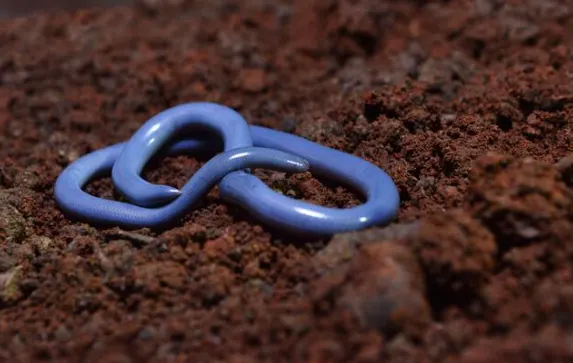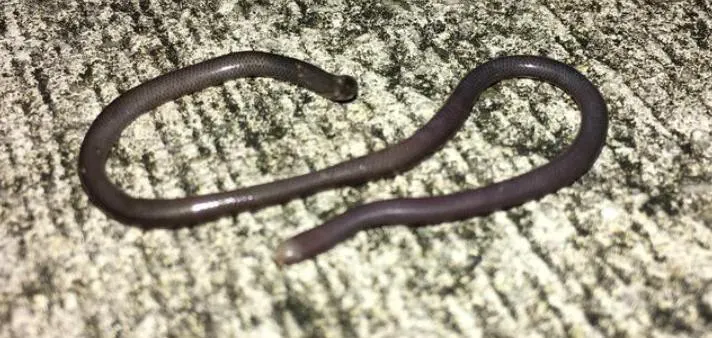The Brahminy Blindsnake, also known as the Flowerpot Snake, is one of nature’s most intriguing and elusive creatures. These tiny, unassuming reptiles are masters of stealth, often going unnoticed even in the most populated areas. Despite their small size and secretive nature, they have managed to spread across every continent except Antarctica, making them one of the most widespread reptiles in the world. But what exactly makes the Brahminy Blindsnake so fascinating?

The World’s Smallest Snake with a Big Impact
At a mere 4.4 to 6.5 inches in length, the Brahminy Blindsnake might easily be mistaken for an earthworm. However, unlike earthworms, these snakes are smooth, shiny, and unsegmented, with a body that glistens in shades of brown, gray, or even purple. Their heads and tails are nearly indistinguishable, with a tiny pointed spur at the end of their tails.
One of the most remarkable aspects of the Brahminy Blindsnake is its parthenogenetic nature. This means that all individuals are female, and they reproduce without the need for a male. Each offspring is a genetic clone of its mother, which has allowed these snakes to spread rapidly across the globe, particularly through the plant trade, where they often hitch a ride in the soil of potted plants.
Evolution and Adaptation: Masters of Their Environment
Belonging to the Typhlopidae family, Brahminy Blindsnakes have a long evolutionary history that dates back to the Middle Jurassic period, about 174 million years ago. Over time, they have developed several adaptations that allow them to thrive in various environments.
These snakes are fossorial, meaning they live and burrow underground. Their vestigial eyes are covered by translucent scales, rendering them blind but capable of detecting light. This adaptation is perfect for their underground lifestyle, where sight is less important than other senses.
Brahminy Blindsnakes are social creatures, often found in groups hiding under rocks, in leaf litter, or beneath debris. Their natural habitats range from the humid jungles of South Asia to the urban gardens of North America, where they have become invasive in many regions. Despite their widespread presence, their exact population remains unknown, and they face no significant threats, earning them a conservation status of Least Concern.
Behavior: Non-Aggressive and Harmless
These tiny snakes are not aggressive and pose no threat to humans. When threatened, they prefer to burrow into the soil rather than bite. If captured, they may release a foul-smelling musk as a defense mechanism or squirm vigorously in an attempt to escape. Interestingly, their presence in homes is often an indicator of ant or termite infestations, as these snakes primarily feed on the eggs, larvae, and pupae of these insects.
If you encounter a Brahminy Blindsnake in your home, the best way to deal with it is simply to pick it up and release it outside. They do not respond well to insecticides, as they are not pests and are beneficial in controlling termite populations.
Habitat: From Forest Floors to Urban Gardens
The Brahminy Blindsnake’s natural habitat includes loose soil, leaf litter, rotting logs, and beneath surface debris in humid environments. However, their adaptability has allowed them to thrive in urban areas, particularly in tropical and semi-tropical climates. These snakes can be found in bathroom floors, between walls, and even under carpets in homes with high humidity levels.
Their invasive nature has led to their introduction in numerous regions, including the United States, where they are prevalent in states like Florida, California, and Hawaii. In some countries, they are even used as a biological control agent to manage termite populations.
Diet: Nature’s Pest Controller
Brahminy Blindsnakes are not hunters in the traditional sense. Instead, they feed on the eggs, larvae, and pupae of ants and termites, which they encounter while burrowing through the soil. Their diet also includes earthworms, caterpillars, crickets, and insect eggs, making them a beneficial presence in gardens and homes alike.

Q&A: All About the Brahminy Blindsnake
Q: Is the Brahminy Blindsnake poisonous?
A: No, Brahminy Blindsnakes are not venomous and pose no danger to humans. Their bite is extremely rare and more of a nuisance than anything harmful.
Q: Can Brahminy Blindsnakes be kept as pets?
A: While they are docile and can be kept as pets, Brahminy Blindsnakes are not particularly interactive or interesting due to their burrowing habits. Their primary diet in captivity would need to include termites and other small insects.
Q: How do I get rid of a Brahminy Blindsnake in my home?
A: The most effective way to remove a Brahminy Blindsnake from your home is to simply pick it up and take it outside. Sealing any cracks or holes that might allow them to enter is also recommended to prevent future occurrences.
Q: What do Brahminy Blindsnakes eat?
A: Brahminy Blindsnakes primarily feed on the eggs, larvae, and pupae of ants and termites. They may also consume other small invertebrates such as earthworms and caterpillars.
Q: Where do Brahminy Blindsnakes live?
A: These snakes are fossorial, meaning they live underground in loose soil, leaf litter, or under rocks and debris. They are found in a variety of habitats, from tropical forests to urban gardens.
The Brahminy Blindsnake may be small and unassuming, but its adaptability and widespread presence make it one of the most fascinating reptiles in the world. Whether you encounter one in your garden or your home, remember that these tiny creatures are not only harmless but also play a crucial role in controlling pest populations.
- Enchi Ball Python: A Unique and Stunning Morph of Python regius - March 27, 2025
- Emerald Tree Monitor: The Enigmatic Green Guardian of the Rainforest - March 26, 2025
- The Egyptian Cobra (Naja haje): A Fascinating Serpent - March 25, 2025
